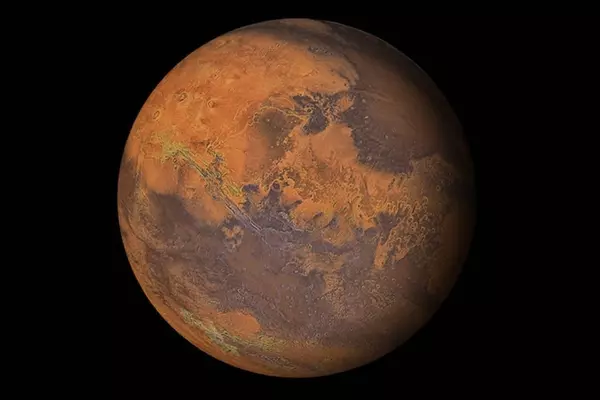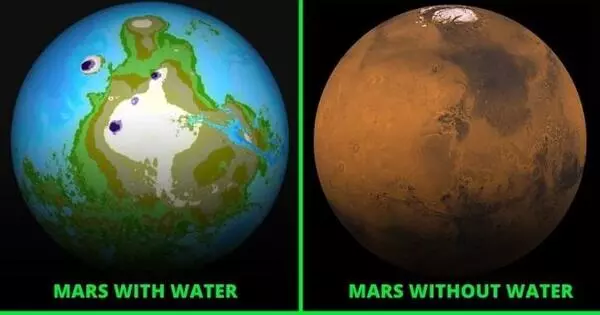It has long been assumed that Mars formerly had oceans, owing to a magnetic field similar to Earth’s. However, the magnetic field vanished, and new research may finally explain why. Researchers reproduced conditions expected billions of years ago in Mars’ core and discovered that the behavior of the molten metal thought to be present likely gave rise to a transient magnetic field that was destined to fade away.
Mars has caught the interest of people for decades, whether due to science fiction or the fact that you can see it with your own eyes from Earth. It’s one of our closest neighbors, and it’s been investigated with a variety of scientific instruments onboard the several unmanned space expeditions that have and continue to explore it. Despite this, there are still major outstanding mysteries concerning Mars, the solutions to which could shed light on our own distant history and future, given that Earth, Mars, and all our neighboring planets were created from the same cosmic substance.
Some major questions regarding Mars have already been solved. For example, scientists know that many observable features on Mars are evidence that it formerly had oceans and a protective magnetic field. But one concern had been bothering Professor Kei Hirose of the University of Tokyo’s Department of Earth and Planetary Science: If there was a magnetic field around Mars, why was it there at all, and why was it there so briefly? Compelled to find an answer, a team lead by Ph.D. student Shunpei Yokoo in the Hirose lab investigated a novel technique to evaluate something so far away in both time and space.
With our findings in mind, we anticipate that additional seismic exploration of Mars will confirm that the core is actually divided into various layers as we predicted. If that is the case, it would help us complete the account of how the rocky planets, including Earth, formed and explain their makeup.
Shunpei Yokoo
“The magnetic field of the Earth is propelled by inconceivably large convection currents of molten metals in its core. Magnetic fields on other planets are thought to function similarly” Hirose stated. “Though the interior composition of Mars is unknown, meteorite evidence suggests it is molten iron enriched with sulphur. Furthermore, seismic measurements from NASA’s InSight mission on Mars’ surface indicate that the planet’s core is larger and less dense than previously thought. These facts point to the inclusion of additional lighter elements, such as hydrogen. With this information, we develop iron alloys that we believe will form the core and test them.”
Diamonds, lasers, and an unexpected surprise were used in the experiment. Yokoo created a sample of Fe-S-H material, which contains iron, sulfur, and hydrogen, and is what he and his team believe the core of Mars was previously made of. They squeezed the sample between two diamonds while heating it with an infrared laser. This was done to approximate the core’s anticipated temperature and pressure. Using X-ray and electron beams, the team was able to observe what was happening during melting under pressure and even map how the sample’s composition changed over that period.

“We were startled to notice a certain behavior that could explain a lot. The previously homogeneous Fe-S-H split into two different liquids with a level of complexity not observed before at these pressures” Hirose stated. “One of the iron liquids was rich in sulphur, the other in hydrogen, and this is crucial in explaining the creation and eventual death of Mars’ magnetic field.”
The liquid iron rich in hydrogen and poor in sulphur, being less dense, would have risen above the denser sulphur-rich, hydrogen-poor liquid iron, causing convection currents. These currents, similar to those on Earth, would have driven a magnetic field capable of maintaining hydrogen in an atmosphere around Mars, which in turn would have allowed water to exist as a liquid. However, it was not to last.
Unlike the Earth’s internal convection currents, which are incredibly long lasting, there would have been no more currents to drive a magnetic field once the two liquids had completely separated. When this occurred, solar wind blew hydrogen in the atmosphere into space, causing the breakup of water vapor and, eventually, the evaporation of the Martian oceans. All of this would have happened around 4 billion years ago.
“With our findings in mind, we anticipate that additional seismic exploration of Mars will confirm that the core is actually divided into various layers as we predicted,” Hirose added. “If that is the case, it would help us complete the account of how the rocky planets, including Earth, formed and explain their makeup. You could be thinking that the Earth’s magnetic field will eventually disappear, but don’t worry, that won’t happen for at least a billion years.”
















